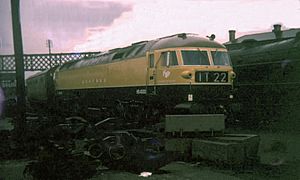British Rail HS4000 facts for kids
Quick facts for kids HS4000 "Kestrel" |
|
 |
|
| HS4000 outside Derby Locomotive Works, 1968-08-31. | |
| Power type | Diesel-electric |
|---|---|
| Builder | Hawker Siddeley, at Brush Traction, Loughborough |
| Serial number | Brush 711 |
| Build date | 1968 |
| UIC classification | Co'Co' |
| Gauge | 4 ft 8 1⁄2 in (1,435 mm) |
| Wheel diameter | 3 ft 9 in (1.143 m) |
| Wheelbase | 51 ft 8 in (15.75 m) |
| Length | 66 ft 6 in (20.27 m) |
| Width | 8 ft 9+3⁄4 in (2.69 m) |
| Height | 12 ft 9+3⁄4 in (3.91 m) |
| Locomotive weight | 133 long tons (135 t) |
| Fuel capacity | 1,000 imp gal (4,500 L; 1,200 US gal) |
| Prime mover | Sulzer 16LVA24 |
| Traction motors | Brush, 6 off |
| Transmission | AC alternator, DC traction motors |
| Top speed | 125 mph (201 km/h) |
| Power output | Engine: 4,000 hp (2,983 kW) At rail: 3,412 hp (2,544 kW) |
| Tractive effort | 70,000 lbf (311.38 kN) |
| Train brakes | Dual (Air and Vacuum) |
| Career | British Railways, Soviet Railways |
| Disposition | Exported to Russia, later scrapped. |
HS4000, named Kestrel, was a prototype high-powered mainline diesel locomotive built in 1968 by Brush Traction to demonstrate its wares to British Railways. The name came from Hawker Siddeley (the owner of Brush) 4000 hp (the power rating of its Sulzer engine).

All content from Kiddle encyclopedia articles (including the article images and facts) can be freely used under Attribution-ShareAlike license, unless stated otherwise. Cite this article:
British Rail HS4000 Facts for Kids. Kiddle Encyclopedia.
